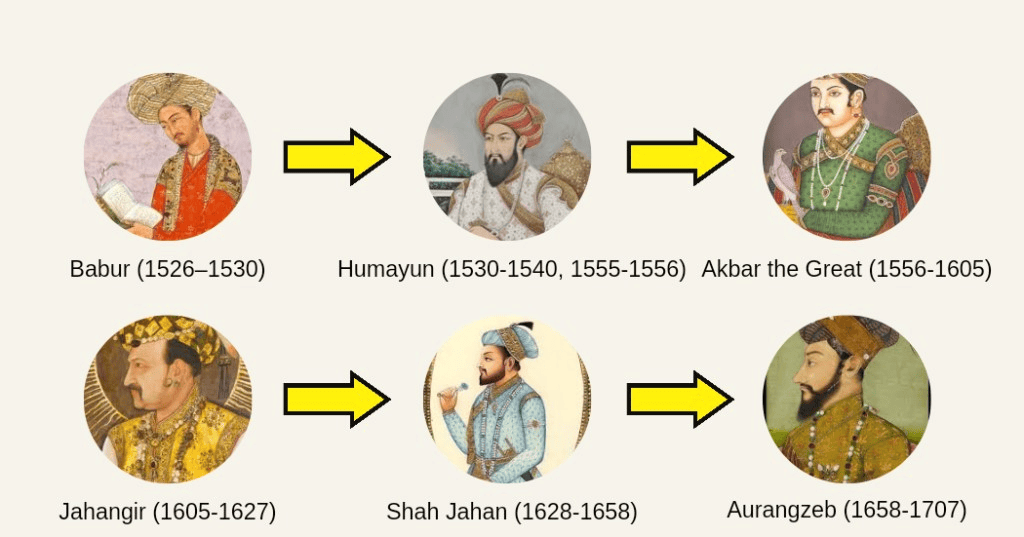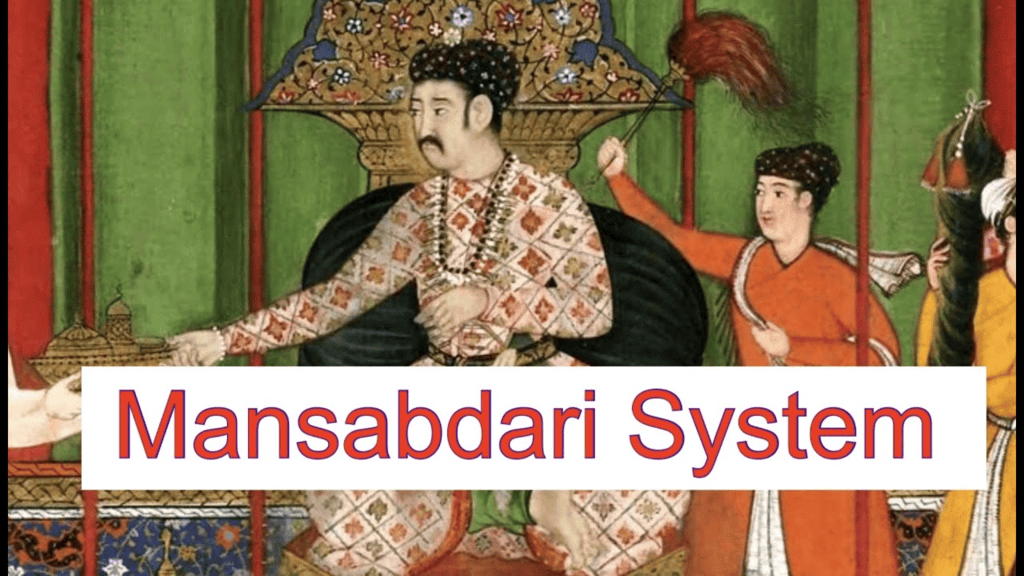Class 7 History Chapter 4 Notes - The Mughal Empire
Introduction to the Mughals
The Indian subcontinent, with its vast territory and rich diversity of people and cultures, posed a significant challenge for any ruler in the Middle Ages. However, the Mughal Empire managed to create a lasting and expansive empire, achieving what previous rulers could only maintain for short periods.
Expansion and Control: The Mughals expanded their kingdom from Agra and Delhi. By the seventeenth century, they had gained control over nearly the entire subcontinent. This expansion was marked by effective governance and administrative structures that the Mughals put in place.
Legacy of Governance: The Mughals not only established their rule but also left behind a political legacy that influenced future rulers of the subcontinent. Their ideas of governance and administrative practices outlasted their empire, shaping the way the region was governed long after their time.
Modern Significance: Today, the legacy of the Mughal Empire is still visible in India. For instance, the Prime Minister of India addresses the nation on Independence Day from the ramparts of the Red Fort in Delhi, which was once the residence of the Mughal emperors. This tradition highlights the enduring impact of Mughal governance and architecture in contemporary India.

Who were the Mughals?
The Mughals were a powerful dynasty with a rich heritage, tracing their origins to two of history's most formidable conquerors.
 Mughal Lineage
Mughal Lineage
Lineage: The Mughals descended from two significant lineages of rulers—Genghis Khan, the Mongol ruler of China and Central Asia, and Timur, the ruler of Iran, Iraq, and modern-day Turkey.
Distancing from Mongol Identity: The Mughals avoided being called "Mughal" or "Mongol" due to Genghis Khan's association with massacres and their rivalry with the Uzbegs.
Pride in Timurid Ancestry: The Mughals took pride in their Timurid heritage, especially because their ancestor, Timur, had captured Delhi in 1398.
Mughal Military Campaigns
The Mughal Empire's rise and expansion were marked by a series of strategic military campaigns that established its dominance across the Indian subcontinent.
 Military campaigns under Akbar and Aurangzeb.
Military campaigns under Akbar and Aurangzeb.
- Babur’s Early Life and Challenges: Babur became the ruler of Ferghana at just 12 years old in 1494. He was forced to leave his throne due to an invasion by the Uzbegs, another Mongol group. After years of wandering, he seized Kabul in 1504.
- Foundation of the Mughal Empire: In 1526, Babur defeated the Sultan of Delhi, Ibrahim Lodi, at the Battle of Panipat. This victory allowed him to capture Delhi and Agra, establishing the Mughal Empire.
Mughal Traditions of Succession
Division of Inheritance in Mughal Tradition
- The Mughals did not follow the practice of primogeniture, where the eldest son inherits the entire estate.
- Instead, they adhered to the Mughal and Timurid custom of coparcenary inheritance, which involves dividing the inheritance among all sons equally.
- This raises the question of which method is fairer: primogeniture or coparcenary.
Mughal Relations with Other Rulers
The Mughal Empire's interactions with other rulers were characterized by military conquests, strategic alliances, and a nuanced approach to governance and taxation.

- Military Campaigns and Expansion:The Mughal rulers frequently waged campaigns against those who refused to accept their authority. As the Mughal Empire grew stronger, many rulers, including the Rajputs, chose to align with them voluntarily.
- Mansabs and Jagirs: The Mughals expanded their territories by offering positions of honor (mansabs) and land grants (jagirs) to allied rulers. This system helped integrate various regions into the Mughal Empire.
- Taxation and Treatment of Defeated Rulers: The primary source of Mughal income was tax on agricultural produce collected from peasants. The Sisodiya Rajputs of Mewar initially resisted Mughal rule but were treated respectfully after defeat. The Mughals returned their lands as assignments, showing a balance between victory and respect.
Mansabdars and Jagirdars
The Mughal administrative system relied on a complex network of mansabdars and jagirdars to manage military and financial responsibilities, presenting both opportunities and challenges for governance.

- Mansabdars and Recruitment: The Mughal Empire recruited a diverse group of individuals, including Turkish nobles, Iranians, Indian Muslims, Afghans, Rajputs, and Marathas, appointing them as mansabdars, who held ranks determining their position, salary, and military duties.
- Jagirs and Revenue System: Mansabdars received salaries through jagirs (revenue assignments), which were intended to match their salary but often fell short, especially during Aurangzeb's reign, leading to increased mansabdars and delays in jagir allocation.
- Administrative Challenges: While most mansabdars did not administer their jagirs directly, relying on servants for revenue collection, the inefficiencies and attempts to maximize revenue by jagirdars led to difficulties, including peasant suffering due to Aurangzeb’s ineffective control.
Zabt and Zamindars

Sources of Income: The Mughal rulers primarily earned income through taxes on peasant produce, collected by rural elites known as Zamindars.
Zabt Revenue System: Akbar’s revenue minister, Todar Mal, conducted a detailed 10-year survey (1570-1580) to set cash taxes on crops. Each province had its own revenue rates, known as the zabt system, which was effective only where detailed land surveys were possible.
Zamindar Power and Rebellions: In some regions, Zamindars held significant power, leading to exploitation and rebellions. Peasant revolts, often involving alliances between Zamindars and peasants, challenged Mughal stability, especially towards the end of the 17th century.
A Closer Look: Akbar’s Policies
Akbar's innovative policies in governance and religion significantly shaped the Mughal Empire, reflecting his commitment to tolerance and effective administration.
- Religious Discussions and Administration: Akbar, during his time at Fatehpur Sikri, engaged in religious discussions with ulemas in the ibadat khana, leading him to reject ritualistic and dogmatic approaches. This led to his policy of Sulh-i kul, or universal peace.
- Governance Structure: Akbar organized his empire into provinces called subas, each governed by a Subedar. His nobles commanded large armies and controlled substantial revenues.
- Documentation and Legacy: Akbar’s policies and achievements are recorded in the book Akbarnama, written by Abul Fazal. His approach to religious tolerance and administration influenced later rulers like Shah Jahan and Jahangir.
The Mughal Empire in the 17th Century and After
The Mughals ruled a large part of India from the early 1500s to the 1700s, known for their wealth and power.
They were great at collecting taxes, running the government, and managing trade.
Their strong military and clever strategies helped them keep control over their vast empire.
Despite their strength, the Mughal Empire faced challenges that eventually led to its decline.
Great Wealth and Power
- The Mughal Empire was very wealthy and powerful. It was known for its luxury goods and was a big part of the global trade network.
- They made a lot of money from taxes, especially on goods like spices, textiles, and metals.
- The Mughal leaders were good at keeping their empire strong and making sure goods flowed smoothly through trade.
Strong Military and Governance
- The Mughals had a strong military that protected their land and kept trade safe.
- They were also skilled at managing the empire, making sure everyone followed the rules and paid their taxes.
- Even though they were strong, they faced many challenges that eventually weakened their control.
Decline

- As time passed, the Mughal Empire started to weaken due to various internal and external challenges.
- New powers and changes in trade routes also contributed to its decline.
- By the late 1700s, the once-mighty empire became much smaller and less powerful.
Key Features of the Mughal Empire
- Wealth and Luxury: The Mughals were known for their wealth and luxury, with emperors like Aurangzeb and Shah Jahan famous for their lavish lifestyles and impressive architecture, such as the Taj Mahal.
- Taxes and Trade: The empire thrived on taxes from trade, especially in goods like spices, textiles, and metals.
- Strong Control: The Mughals had a strong military and effective governance, ensuring smooth trade and tax collection.
- Cultural Blend: They blended Persian, Indian, and Islamic cultures, seen in their art, architecture, and daily life.
The Mughal Empire in the Seventeenth Century and After
- The Mughal Empire was administered and militarily efficient, leading to great economic and commercial prosperity.
- International travelers described it as a land of incredible wealth, although they also noted stark inequality.
- Documents from the reign of Shah Jahan show that the top 445 mansabdars(5.6% of the total)received 61.5% of the empire's revenue as salaries.
- The Mughal emperors and mansabdars spent heavily on goods and salaries, benefiting artisans and peasants but leaving little for investment by primary producers.
- The wealth of the Mughal elite made them powerful, and as the emperor's authority declined, regional servants became powerful leaders, forming new dynasties.
- By the eighteenth century, these provinces had developed their own political identities, even while acknowledging the Mughal emperor in Delhi.
Important Dates
- 1237: Genghis Khan died.
- 1404: Jimur died.
- 1526-1530: Reign of Babur. He captured Delhi in 1526 by defeating Ibrahim Lodi and laid the foundation of the Mughal Empire.
- 1539: Sher Shah defeated Humayun at Chausa.
- 1540: Sher Shah again defeated Humayun, this time at Kanauj.
- 1555: Humayun recaptured Delhi1556: Akbar became the Mughal Emperor at the age of 12.
- 1568: Akbar seized Sisodiya capital of Chittor
- 1569: Akbar seized Ranthambhore
- 1605-1627: Jahangir ruled over Delhi as the Mughal emperor
- 1627-1658: Shah Jahan reigned over Delhi.
- 1632: Ahmadnagar was annexed by Shah Jahan
- 1658-1707: Aurangzeb reigned over Delhi.
- 1685: Aurangzeb annexed Bijapur
- 1687: Aurangzeb annexed Golconda
- 1698: Aurangzeb campaigned in the Deccan against the Marathas.
FAQ's
Q.1. What was the culture of the ancient Mughals?
Ans. The Empire he founded was a sophisticated civilisation based on religious toleration. It was a mixture of Persian, Mongol and Indian cultures.
Q.2. What was the Mughal Empire known for?
Ans. The Mughal Empire was important for bringing almost the entire Indian subcontinent under one domain. They also had an influence on the architecture and culture aspect.
Q.3. What is the meaning of ‘Zabt’?
Ans. Zabt was a type of land revenue system that was framed during the Mughal period.
|
66 videos|336 docs|46 tests
|
FAQs on Class 7 History Chapter 4 Notes - The Mughal Empire
| 1. Who were the Mughals and what was their significance in Indian history? |  |
| 2. What were the key military campaigns of the Mughal Empire? |  |
| 3. How did Mughal traditions of succession impact the stability of the empire? |  |
| 4. What role did Mansabdars and Jagirdars play in the Mughal administration? |  |
| 5. What were Akbar’s key policies and their impact on the Mughal Empire? |  |

|
Explore Courses for Class 7 exam
|

|













